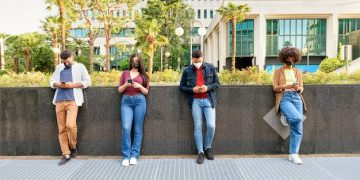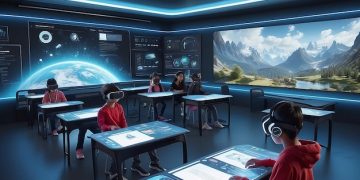Personalized Learning: Is It Effective for All Students in the US?

Personalized learning, a growing trend in US education, tailors instruction to meet individual student needs, but its effectiveness for all students remains a subject of debate due to varying learning styles, resource availability, and potential equity concerns.
The educational landscape in the US is constantly evolving, with new approaches emerging to enhance student outcomes. Among these, the growing trend of personalized learning: is it effective for all students?
What is personalized learning?
Personalized learning is an educational approach that aims to customize learning for each student’s strengths, needs, skills, and interests. It moves away from a one-size-fits-all model and toward a more tailored and flexible learning experience.
This approach often involves:
- Student-driven learning: Giving students more control over their learning paths and pace.
- Flexible content and tools: Using a variety of materials and technologies to cater to different learning styles.
- Competency-based progression: Allowing students to advance based on their mastery of concepts, rather than seat time.
Personalized learning is a shift in mindset but does it work well?
Key Components of Personalized Learning
Personalized learning is not just about using technology in the classroom. So let’s take a closer look.
- Personalized learning pathways – allowing students to go at their own pace.
- Having regular check-ins to make sure the student is understanding the material.
- Using technology to enhance learning like educational apps.
Personalized learning tailors education to individual needs to create a learning environment unique to a student. In doing this, here are some elements for a successful personalized learning implementation. Creating education that is effective for a variety of student.

Benefits of Personalized Learning
There are several reasons why personalized learning has gained traction in recent years. Let’s start with these benefits below:
- Increased student engagement: By tailoring learning to individual interests and learning styles, students are more likely to be motivated and engaged.
- Improved academic outcomes: Personalized learning can lead to better understanding and retention of material, as students learn in ways that resonate with them.
- Development of lifelong learning skills: Students learn to take ownership of their education and develop skills in self-direction, problem-solving, and critical thinking
Personalized learning offers the potential to address learning gaps and improve outcomes but can it work for everyone?
Challenges with Implementation
There is an abundance of benefits that come with personalized learning, but there are a few challenges as well.
- Resistance to change by educators.
- Implementing personalized learning requires sufficient funding.
- Being able to maintain students’ learning and not letting certain students fall behind.
Educators, policymakers, and technology developers often have to work together to combat these challenges.
The Role of Technology in Personalized Learning
Technology is a key enabler in the implementation of personalized learning. Digital tools and online platforms can provide access to a vast array of resources, facilitate data-driven instruction, and support communication and collaboration.
Through the use of technology, educators are able to use data to tailor lessons to students.
- Learning management systems (LMS): These platforms can track student progress, provide personalized feedback, and deliver customized content.
- Adaptive learning software: This software adjusts the difficulty and content based on individual student performance.
- Online resources: Students can access a wide range of videos, articles, and interactive activities to supplement their learning.
Technology offers powerful tools to support personalized learning, but it is important to use these tools thoughtfully and strategically to balance it out with traditional teaching methods.

Equity Concerns in Personalized Learning
While personalized learning has the potential to benefit all students, there are concerns that it may exacerbate existing inequalities in education. It raises fundamental questions about access, resources and support.
The concerns include:
- Lack of access to technology: Students from low-income families may not have access to the devices and internet connectivity needed to fully participate in personalized learning programs.
- Quality of resources: The quality of online resources and adaptive learning software can vary significantly, and some students may not have access to high-quality materials.
- Teacher training and support: Personalized learning requires teachers to have the skills and knowledge to effectively differentiate instruction and use data to inform their practice, and not all teachers have access to adequate training and support.
There are a number of ways that personalized learning can be successful, it’s important that we take on the questions around equity.
Accessibility Matters
Accessibility is one of the most important factors of personalized learning. Making sure that learning is accessible helps with equity concerns. Let’s take a look.
- Having access to technology to ensure every student can have personalized educational pathways.
- Having access to high-quality learning material.
- Support of educators to guide the students.
When these factors are in place, personalized learning can truly be successful!
The Role of Teachers in Personalized Learning
In a personalized learning environment, the role of teachers shifts from being lecturers to facilitators, coaches, and mentors. Teachers have to encourage students and create a successful environment.
Teachers have to:
- Design personalized learning plans: Collaborating with students and families to create individualized learning goals and pathways.
- Provide ongoing support and feedback: Monitoring student progress, providing targeted interventions, and offering personalized feedback.
- Create a supportive learning environment: Fostering a culture of collaboration, independence, and self-reflection.
One of the things that teachers have to do is manage student expectations around personalized learning.
The Future of Personalized Learning
Personalized learning is here to stay, and its future looks promising. As technology continues to advance and our understanding of learning grows, personalized learning will become more sophisticated and effective.
The most important trends for personalized learning are below:
- Artificial intelligence (AI): AI-powered tutoring systems and personalized learning platforms will provide even more tailored support and guidance.
- Virtual and augmented reality (VR/AR): VR and AR technologies will create immersive and engaging learning experiences that cater to different learning styles.
- Expanding access to personalized learning: Policymakers and educators will work to ensure that all students have access to high-quality personalized learning opportunities, regardless of their background or location.
Personalized learning is a growing trend in education and can continue to grow.
So to answer our initial question, can personalized learning be effective for all students? By paying attention to factors like equity and accessibility, the answer is yes, personalized learning can be effective for all students! By implementing the keys to personalized learning, the education landscape has the power to evolve!
| Key Point | Brief Description |
|---|---|
| 💡Tailored Education | Adapts learning to individual student needs and interests. |
| 🚀Increased Engagement | Motivates students by aligning with their passions and learning styles. |
| 💻Technology’s Role | Utilizes digital tools for personalized feedback and customized content. |
| ⚖️Equity Concerns | Addresses disparities in access to technology and quality resources. |
Frequently Asked Questions
▼
Competency-based progression allows students to advance based on their mastery of concepts. That means that when students are proficient, they move ahead! It’s a concept that challenges tradition, but works well for personalized learning.
▼
Technology delivers customized content and allows students to enhance learning. With the right tech, students can access learning anywhere. That is the value of technology!
▼
Teachers foster a culture of collaboration and provides support. Teachers also keep the students engaged and accountable. It might seem like personalized learning is just up to the students, but it’s not!
▼
Policy makers and educators are working to provide access to students, making sure they have access to high-quality materials. By making sure that all students have access, equity concerns can be combatted!
▼
Data can be leveraged through analyzing student progress, identifying intervention areas and tailoring learning plans. That way learning can be enhanced through data.
Conclusion
In conclusion, personalized learning stands as a promising educational trend in the US, emphasizing student-centered approaches and leveraging technology to tailor instruction. While potential challenges like equity concerns and implementation barriers exist, the focus is on leveraging technology to cater to different learning styles. Personalized learning can be a catalyst for transformative improvements in the educational experiences of all students.





